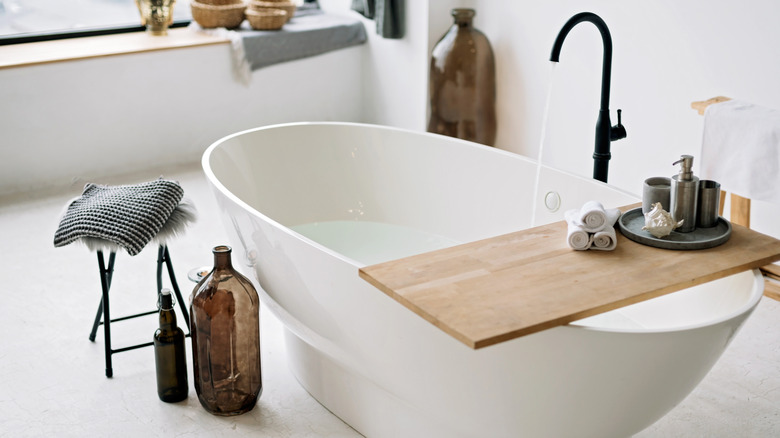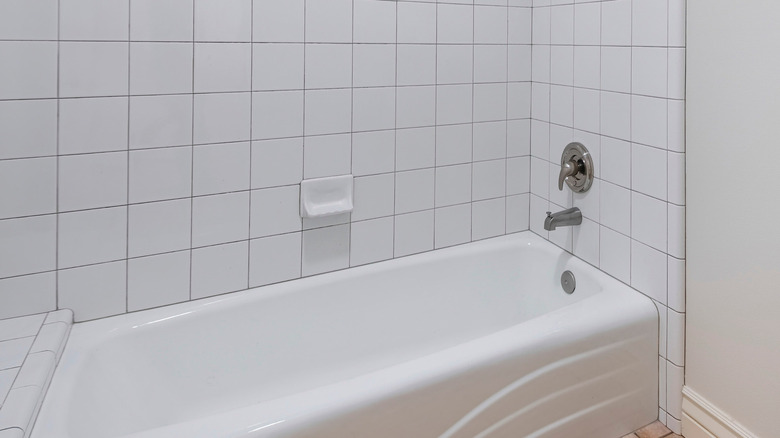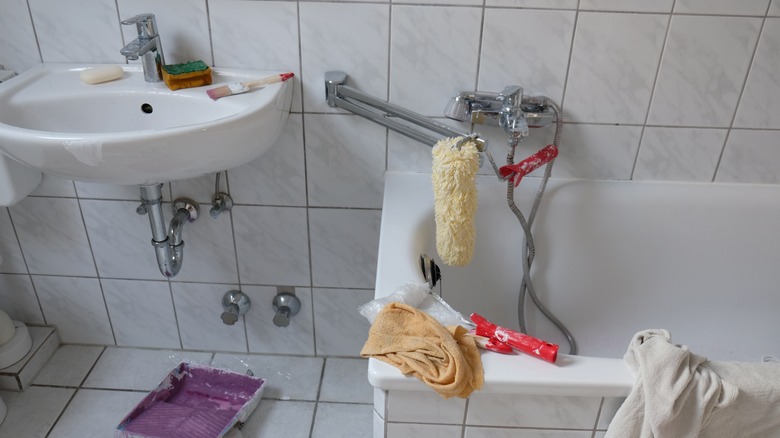What You Need To Know To Paint A Bathtub
There's quite a lot to think about when updating a bathroom, and one important consideration is cost. For instance, full master bathroom renovation services through The Home Depot starts at $30,000. In addition to fixtures such as a new toilet, vanity, lighting, and shower, costs such as demolition, labor, and additional materials factor into the overall total.
However, not every bathroom needs a full renovation. Sometimes, fully functioning bathrooms just have outdated designs or color schemes. If this is the case for you, maybe you've considered painting (or reglazing) your bathtub. According to Home Advisor, this process can be applied to either ceramic, porcelain, or fiberglass tubs, and professional services will cost between $350 and $600. Despite the higher cost, Designing Vibes recommends hiring a professional as it can be far more convenient, long-lasting, and the work will be covered under a warranty. However, if you do decide to go the DIY route like blogger Angie details on House Becoming Home, you can get the job done for as little as $25. Here are a few things to consider before getting your hands dirty.
What to know before you begin
If you're thinking about painting your tub yourself, the main thing you'll need (and you'll need a lot of it) is patience, according to Designing Vibes. While actually painting the tub only takes a day, the preparation can be tedious, and when painting, you'll want to work with extreme care for the best results. The second thing you'll want to consider is timing. According to House Becoming Home, the fumes are no joke. You'll want to paint during nice weather when you can open windows and utilize fans in addition to wearing a respirator mask and protective eyewear.
Another thing to consider is how durable a DIY-painted tub really is. According to Renovations Roofing, DIY tub painting kits typically include water-based formulas, whereas professional painters tend to use more durable but difficult to apply oil-based materials. Because of this, professionally painted tubs will last longer. They also often come with a warranty. If your tub gets frequent use, your DIY paint job may need to be touched up down the line, as the finish chips or fades. To increase longevity, clean your repainted tub with gentle cleaners rather than harsh chemicals that can wear away the finish.
How to paint a tub
If you're still set on painting the tub yourself, here's how you do it. To start, remove existing bath fixtures and any old caulk at the seams. Next, use epoxy putty to fill any chips or divots, as House Becoming Home demonstrates. Next, you'll need to sand and then clean the entire bathtub. For a natural method, you can use vinegar, water, and lemon to create a sprayable cleaner. This Old House suggests you use a 2 to 1 ratio of water to vinegar for fiberglass tubs and a 1 to 1 ratio for porcelain surfaces. Then add 2 tablespoons of lemon juice. After spraying, let the mixture sit for 15 to 20 minutes, and then wipe with a damp rag or sponge.
After the preparation work, don't forget to open all windows or turn on fans for better circulation. Then open your paint and apply it to a quality roller. Some paints have a base and activator that need to be mixed together, so be sure to follow the instructions for your particular kit. When painting, start on the hardest-to-reach areas and move to the easily accessible regions, per House Becoming Home. Apply the paint in two thin layers, allowing ample time in between for the first layer to dry. Once you're finished, you can celebrate a job well done, but you'll need to wait 2 to 3 days before filling the tub with water, per HomeAdvisor.


